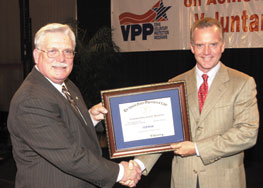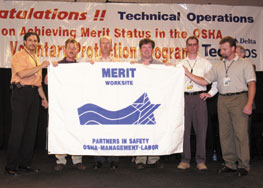 |

|
| |
Flying High for Safety |
 |
| |
by Lance Lamberton |
 |
| |
Delta Air Lines is the first commercial airline
to join OSHA's Voluntary Protection Programs.
|
 Safety has always been the number one focus at Delta Air Lines and that should come as no surprise. As the third-largest commercial carrier in the United States, transporting more than 100 million passengers each year to destinations throughout the world, Delta's management team knows that the company's success or failure rests more on its safety record than anything else. Mac Armstrong, senior vice president for the Air Transport Association and Delta's former executive vice president, says, "Safety is a pass/fail item, in that if you fail at safety, the other stuff doesn't matter." Safety has always been the number one focus at Delta Air Lines and that should come as no surprise. As the third-largest commercial carrier in the United States, transporting more than 100 million passengers each year to destinations throughout the world, Delta's management team knows that the company's success or failure rests more on its safety record than anything else. Mac Armstrong, senior vice president for the Air Transport Association and Delta's former executive vice president, says, "Safety is a pass/fail item, in that if you fail at safety, the other stuff doesn't matter."
The most obvious and visible measure of safety performance for an airline is transporting passengers and crew from point A to point B without incident. Less visible, but no less important, is the safety of workers who maintain, repair, and overhaul those planes and who play such a critical role in ensuring the safety of the flying public.
Traditionally, Delta Air Lines has done a very good job in its 75-year history of providing for the health and safety of its workers. Its culture encourages and fosters continuous improvement, so when Delta began looking for additional ways to improve its safety performance, it gave a good, hard look at OSHA's Voluntary Protection Programs (VPP), and decided the programs were a winner.
Delta assembled its VPP team in June 1999 to review the VPP requirements and assess the airline's readiness for the program in the Engine, Component, and Ground Support Equipment Maintenance operating units within the company's Technical Operations Division. The first task was to evaluate Delta's employee safety and health policies and procedures in accordance with VPP criteria. The four main elements of this review were management commitment and employee participation, worksite analysis, hazard prevention and control, and safety and health training.
 Upon completing this review, the VPP team made recommendations for improvement and put several action plans into place. One was to educate all personnel about VPP. Another was to add all the VPP elements to a safety business plan to ensure leadership commitment and employee involvement. The team developed and implemented hazard reporting and tracking, along with a safety and health performance plan. And finally, how well the business plan and its performance objectives were met was made a part of each team member's performance evaluation for calendar year 2000. Upon completing this review, the VPP team made recommendations for improvement and put several action plans into place. One was to educate all personnel about VPP. Another was to add all the VPP elements to a safety business plan to ensure leadership commitment and employee involvement. The team developed and implemented hazard reporting and tracking, along with a safety and health performance plan. And finally, how well the business plan and its performance objectives were met was made a part of each team member's performance evaluation for calendar year 2000.
| "Safety is a pass/fail item, in that if you fail at safety, the other stuff doesn't matter." |
After implementing these action plans, Delta prepared and submitted its VPP application to OSHA in April 2000. An OSHA VPP onsite review followed in May 2000. During the review, OSHA's assessment team verified that Delta's Engine, Component and Ground Support Equipment Maintenance operating units had met the entry-level standards. In the ensuing months, the three operating units identified and worked on longer-term issues such as effective contractor safety management and emergency response procedures.
After Delta had addressed these items, OSHA granted the operating units VPP Merit status in January 2001, making Delta the first major commercial airline to apply for and receive this distinguished recognition. In May 2001, OSHA's then-Acting Assistant Secretary, Davis Layne, presented the Merit flag to Delta at a celebration in Atlanta's maintenance facility. Thousands of cheering maintenance technicians participated.
In making the presentation, Layne said, "Delta's Technical Operations Division has shown that it can deliver top-notch maintenance on a large fleet of commercial aircraft while preserving the well-being of its employees. Technical Operations is a model for others who want to improve their safety and health programs."
| The direct involvement of Delta's frontline employees was key to achieving VPP status. |
Key to achieving Merit status for such a large workforce was the direct involvement of Delta's frontline employees. According to Delta's chief operating officer, Frederick Reid, "Implementation of VPP is a bottomup, not a top-down process. It is our frontline employees and their involvement that has made it possible for us to come this far. Reid says the management role is limited to that of an enabler and facilitator, "someplace where the front line can go to eliminate roadblocks and barriers to implementation." But he says it is the employees who actually do the work of maintaining the planes and identify what needs to be done to improve upon the company's workplace safety performance."
 This direct employee involvement and a bottom-up approach to safety issues proved critical to overcoming the biggest challenge faced by Delta: the sheer size of the operation and the number of potential hazards faced on any given day. As pointed out by Delta's VPP team leader, Joe Murzynsky, "There are well over 2,300 employees in the three departments that have earned Merit status. They work in a 24-hour-a-day, 7-day-a-week facility with 12 maintenance bays in three different hangars, maintaining a fleet of 575 aircraft and a huge array of ground support. In that environment, we have identified more than 1,000 workplace hazards that run the gamut from noise, fumes, spills, falls, and electricity to ergonomic hazards such as repetitive motion, lifting, pushing, pulling, and bending. This direct employee involvement and a bottom-up approach to safety issues proved critical to overcoming the biggest challenge faced by Delta: the sheer size of the operation and the number of potential hazards faced on any given day. As pointed out by Delta's VPP team leader, Joe Murzynsky, "There are well over 2,300 employees in the three departments that have earned Merit status. They work in a 24-hour-a-day, 7-day-a-week facility with 12 maintenance bays in three different hangars, maintaining a fleet of 575 aircraft and a huge array of ground support. In that environment, we have identified more than 1,000 workplace hazards that run the gamut from noise, fumes, spills, falls, and electricity to ergonomic hazards such as repetitive motion, lifting, pushing, pulling, and bending.
"Getting an operation that size to make significant change is like changing the course of an ocean liner," says Murzynsky. "Yet that is exactly what we have done by involving the folks who will be most directly affected in a positive way by the changes."
 Thanks to VPP, Delta has been able to document and track these identified hazards, which in turn has allowed the company to reinforce safe work actions and identify proper policies and procedures for the performance of each job. Although it is still too early to provide any definitive measure on how much safer Delta's Technical Operations Division is as a result of VPP, Jim Maucere, Delta's vice president of Base, Engine, and Component Maintenance is optimistic. "Over the past few years, we have reduced workplace injuries by 41 percent from 1996 to 2000," Maucere says. "With the implementation of VPP, I look forward with confidence to those numbers continuing to come down until Delta becomes the standard for workplace health and safety in the airline industry." Thanks to VPP, Delta has been able to document and track these identified hazards, which in turn has allowed the company to reinforce safe work actions and identify proper policies and procedures for the performance of each job. Although it is still too early to provide any definitive measure on how much safer Delta's Technical Operations Division is as a result of VPP, Jim Maucere, Delta's vice president of Base, Engine, and Component Maintenance is optimistic. "Over the past few years, we have reduced workplace injuries by 41 percent from 1996 to 2000," Maucere says. "With the implementation of VPP, I look forward with confidence to those numbers continuing to come down until Delta becomes the standard for workplace health and safety in the airline industry."
Following the lead of Engine, Component and Ground Support Equipment Maintenance operating units earning Merit status, another Delta operating unit has stepped up to the plate. In August 2001, an OSHA assessment team announced that it was recommending Merit status for Base Maintenance, an operating unit with 2,700 employees in Atlanta. The goal is for all operating units in Delta's Technical Operations Division to achieve Merit status, and eventually Star status. Given the enthusiasm and commitment already exhibited, they are well on their way.
|
| Lamberton is the Manager of Corporate Communications for Delta's Technical Operations Division in Atlanta. |
|
|

